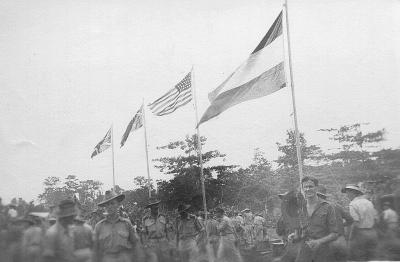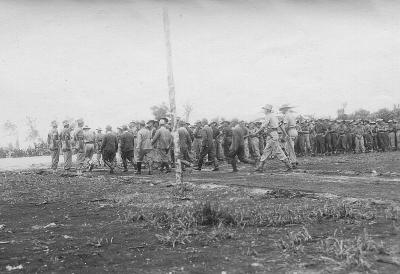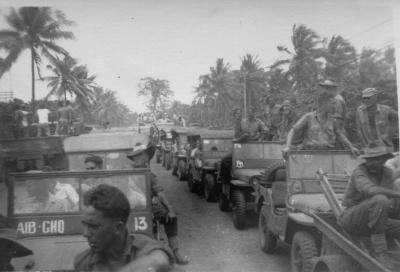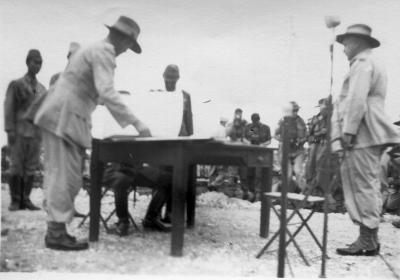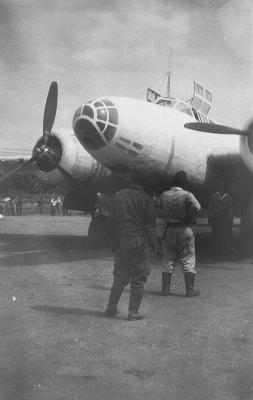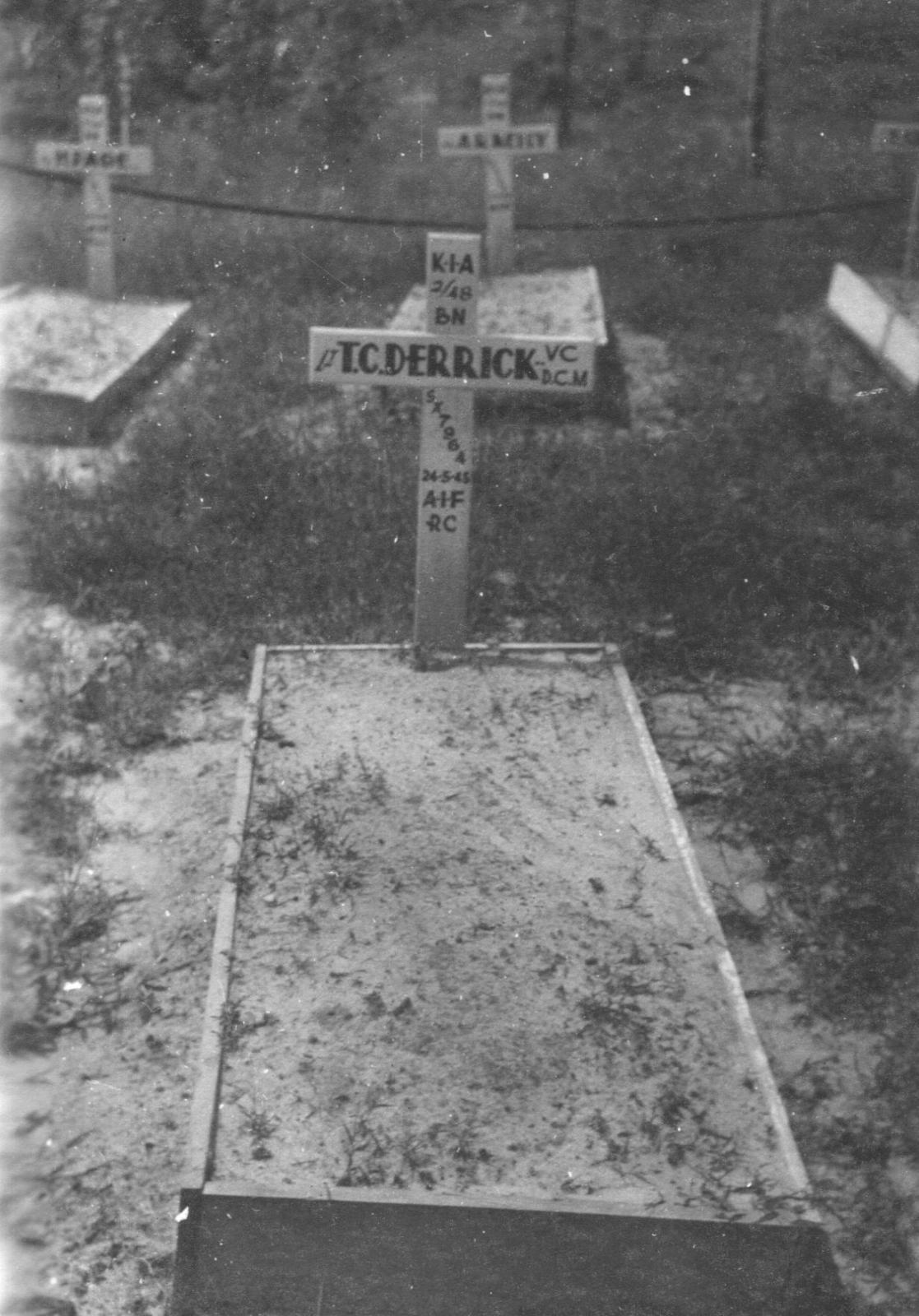World War 2, Borneo, SX7964 DERRICK, 1945
1945Grave of SX7964 Lieutenant T Derrick Victoria Cross 2/48 Battalion Killed in Action 24 May 1945
Derrick, Thomas Currie (Tom) (1914 - 1945)
by Bill Gammage
Thomas Currie (Tom) Derrick, vineyard worker and soldier, was born on 20 March 1914 in the Salvation Army hospital at Medindie, Adelaide, eldest son of David Derrick, a labourer from Ireland, and his native-born wife Ada, née Whitcombe. The Derricks were battlers. Tom walked, often barefooted, to two primary schools in succession—Sturt Street Public School in the city and Le Fevre Peninsula School, Port Adelaide.
He left school as soon as he could, aged 14. By then he was a bit of a larrikin around the Port, venturesome and quick-witted, keen on boxing, Australian Rules football, cricket and gambling. During the Depression his cheeriness found him odd jobs, fixing bikes, selling newspapers and working for a local baker. Early in 1931 he and some mates rode their bikes about 140 miles (225 km) to Berri, on the Murray River, chasing work. 'Diver', as he was now nicknamed, did long spells in the local 'susso' camp, once living on grapes for a week, but in late 1931 talked his way into work on a vineyard at Winkie. He stayed nine years.
In the presbytery of St Laurence's Catholic Church, North Adelaide, on 24 June 1939 Derrick married Clarance Violet ('Beryl') Leslie. As with C. J. Dennis's Ginger Mick, whom in peace and war Derrick so much resembled, marriage gave his life a more serious purpose. He did not volunteer for the Australian Imperial Force until 26 June 1940 and enlisted on 5 July. Although never overtly religious, he became a convert to Catholicism (his wife's religion) in early 1945. When Tom was at the war, Beryl walked almost every day to the post office, hoping for news of him.
On 17 November 1940 Derrick had embarked for the Middle East with the 2nd/48th Battalion, which was to be the most decorated unit in the A.I.F. In that distinguished company Derrick was outstanding. At Tobruk, Libya (April to October 1941), his enthusiasm and aggression in patrolling enemy positions brought him promotion to corporal, and he was probably recommended for a Military Medal on 1 May 1941. An officer at this time described him as 'resourceful, brave, aware, humane, forever bending over backwards for his men'.
At Tel el Eisa, Egypt, on 10-11 July 1942 Derrick ran forward through a barrage of grenades, destroyed three machine-gun posts and captured over a hundred prisoners. He then inspired the defence against a counter-attack, wrecking two tanks with sticky grenades. Awarded the Distinguished Conduct Medal, he was promoted sergeant on 28 July. At El Alamein in late October he showed his customary leadership and daring during a week of violent battle. Only forty-one of his battalion still stood at the end of that week, and Diver had been slightly wounded, but he destroyed three more machine-gun posts, and those who saw him were certain he had earned a V.C.
The 2nd/48th returned to Australia in February 1943 and trained in North Queensland and Papua before helping to capture Lae, New Guinea, in September. By 24 November the battalion was attacking the heights of Sattelberg, overlooking Finschhafen. Late that afternoon, while leading the advance platoon, Derrick confronted an almost vertical slope of thick jungle hiding Japanese machine-guns, and above that an open patch stretching menacingly 100 yards (91 m) towards the crest. Diver was told to withdraw, but he decided to go on. Covered by his mates, he scrambled hands and feet up the cliff, hurling grenades into enemy posts and clearing them out with his rifle. Even in peacetime the climb is barely possible, yet Derrick cleared ten machine-gun posts, stopping just short of the crest as dusk fell. It was one of the most astonishing feats of the war. He was awarded the V.C. (22 March 1944). In North Africa he had remarked that his D.C.M. had come in a Comforts Fund parcel; now he said that his achievement was due mainly to his mates.
In February 1944 the 2nd/48th again returned to Australia, and in August Derrick was posted to an officer-training unit. On being commissioned lieutenant in November, he became one of the few second A.I.F. men promoted from the ranks who rejoined their old battalions. On 1 May 1945 the 2nd/48th took part in the landing at Tarakan, Borneo, and soon pushed inland. On the 22nd/23rd Derrick led his platoon against a small hill, code-named Freda, thick with enemy defences. His skill and courage that day might easily have seen him awarded a second Victoria Cross. but by night the enemy still held the highest knoll. Derrick spread out his men, then lay down on the jungle track to rest. At about 3 o'clock next morning a Japanese light machine-gun, on a fixed line, fired a burst down the track. Diver sat up to see that his men were O.K., the gun fired again, and five bullets caught him in an arc from his left hip to his right chest. He lay back quietly, and, after a time, said to a mate, 'I've had it. That's that. Write to Beryl'. He continued to direct operations until mid-morning. Then they carried him back, his grin and his courage never deserting him. He died on 24 May 1945 and was buried in Labuan war cemetery, plot 24, row A, grave 9. His wife survived him. (Sir) Ivor Hele's portrait of Derrick is held by the Australian War Memorial, Canberra.
Derrick looked the archetypal digger: a fine photo of him on the dustjacket of Allan Dawes's 'Soldier Superb' (Sydney, 1944) became one of the best-known Australian images of the war. It shows a man fit, strong and stocky (he was 5 ft 7 ins [170 cm] tall), a deep tan matching his dark hair, a cocky grin stoking the laughter lines around his brown eyes. It suggests both the larrikin and the professional, both the man who stuck by his mates and the born leader. It leaves unstated the man with such brilliant tactical judgement, such concern for his men, such modesty, such courage, such flair for being a soldier. It does not reveal the man who collected butterflies, who wrote poetry and kept a wartime diary, who liked rhyming slang. It does not say that here is one of the finest fighting soldiers of the war.
Derrick displayed the most fearless bravery throughout four years of battle. When he might honourably have quit the field he insisted on going back. Very few soldiers can compare with him. War gave him distinction, but he gave life honour. He was an extraordinary man.
Details
Details
The KING has been graciously pleased to approve the award of the VICTORIA CROSS to:-
Sergeant Thomas Currie Derrick, D.C.M., Australian Military Forces.
For most conspicuous courage, outstanding leadership and devotion to duty during the final assault on Sattelberg in November, 1943.
On 24th November, 1943, a company of an Australian Infantry Battalion was ordered to outflank a strong enemy position sited on a precipitous cliff-face and then to attack a feature 150 yards from the township of Sattelberg. Sergeant Derrick was in command of his platoon of the company. Due to the nature of the country, the only possible approach to the town lay through an open kunai patch situated directly beneath the top of the cliffs. Over a period of two hours many attempts were made by our troops to clamber up the slopes to their objective, but on each occasion the enemy prevented success with intense machine-gun fire and grenades.
Shortly before last light it appeared that it would be impossible to reach the objective or even to hold the ground already occupied and the company was ordered to retire. On receipt of this order, Sergeant Derrick, displaying dogged tenacity, requested one last attempt to reach the objective. His request was granted.
Moving ahead of his forward section he personally destroyed, with grenades, an enemy post which had been holding up this section. He then ordered his second section around on the right flank. This section came under heavy fire from light machine-guns and grenades from, six enemy posts. Without regard for personal safety he clambered forward well ahead of the leading men of the section and hurled grenade after grenade, so completely demoralising the enemy that they fled leaving weapons and grenades. By this action alone the company was able to gain its first foothold on the precipitous ground.
Not content with the work already done, he returned to the first section, and together with the third section of his platoon advanced to deal with the three remaining posts in the area. On four separate occasions he dashed forward and threw grenades at a range of six to eight yards until these positions were finally silenced.
In all, Sergeant Derrick had reduced ten enemy posts. From the vital ground he had captured the remainder of the Battalion moved on to capture Sattelberg the following morning.
Undoubtedly Sergeant Derrick's fine leadership and refusal to admit defeat, in the face of a seemingly impossible situation, resulted in the capture of Sattelberg. His outstanding gallantry, thoroughness and devotion to duty were an inspiration not only to his platoon and company but to the whole Battalion.
Open in Google Maps
Nearest geotagged records:
Australian Army Museum of Western Australia
Australian Army Museum of Western Australia
Other items from Australian Army Museum of Western Australia
- World War 2, Australia Western Australia Araluen, 1945
- World War 2, North East Indonesia , 1945
- World War 2, South West Pacific, Borneo, Tarakan, 1945
- World War 2, North East Indonesia Morotai, 1945
- World War 2, North East Indonesia, 1945
- World War 2, North East Indonesia Morotai, Surrender Ceremony, 1945
- World War 2, North East Indonesia Morotai, 1945
- World War 2, North East Indonesia, 1945
- World War 2, North East Indonesia, 1945
- World War 2, North East Indonesia, 1945
- World War 2, North East Indonesia , 1945
- World War 2, North East Indonesia Morotai, 1945




